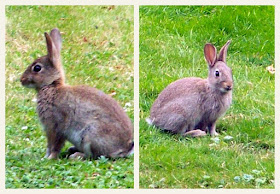
The Cambridge Folk Museum is housed in an old Inn and is a fascinating place. The building itself dates from around 1600 and for 300 years was The White Horse Inn.

The courtyard of the Museum
As you walk in from the reception area the first rooms are the bar and snug from the old public house and then through to the kitchen.

Up stairs in the guest bedroom was a small walk-in cupboard at the side of the fireplace; this was used for powdering wigs. In the 18th century lots of people wore wigs and they would need to be stored on a stand overnight and powdered before wearing, the little room had a shelf - presumably for the wig stand - and a window to the outside through which to shake off the excess powder.
 I loved these old houses - this was the view across the road from the top floor where there were displays on Fenland crafts and working life - things like eel catching and wildfowling - and a childhood room. From here I wandered up to Kettles Yard and looked around the gallery although the house wasn't open until later in the day.
I loved these old houses - this was the view across the road from the top floor where there were displays on Fenland crafts and working life - things like eel catching and wildfowling - and a childhood room. From here I wandered up to Kettles Yard and looked around the gallery although the house wasn't open until later in the day. It was time to wander back to the bridge and take a walk along the River Cam before it got too warm and I wanted to see punts, below the river on Quayside near Jesus Green.
It was time to wander back to the bridge and take a walk along the River Cam before it got too warm and I wanted to see punts, below the river on Quayside near Jesus Green. At 2p.m. it felt like lunch time so I popped into M&S for sandwiches and a drink and sat in St Mary's churchyard - like many other people - in a shaded corner to eat my lunch.
At 2p.m. it felt like lunch time so I popped into M&S for sandwiches and a drink and sat in St Mary's churchyard - like many other people - in a shaded corner to eat my lunch.
I had a couple of hours before I had to return to the Gonville Hotel so I wandered up towards the Fitzwilliam Museum where it was cool and fairly quiet - here are a few of the photos I took along the way.
 The Corpus Clock outside the Taylor Library of Corpus Christi College. It was designed by John Taylor - who explains about it here
The Corpus Clock outside the Taylor Library of Corpus Christi College. It was designed by John Taylor - who explains about it here
Window box in the quad of Peterhouse College
At the Fitzwilliam museum I looked at the Darwin exhibition and then - you've guessed - back to the rabbits again! As you can see from my little souvenirs from the shop - but I'll tell you more about 'The Macclesfield Psalter' in a later post.












































